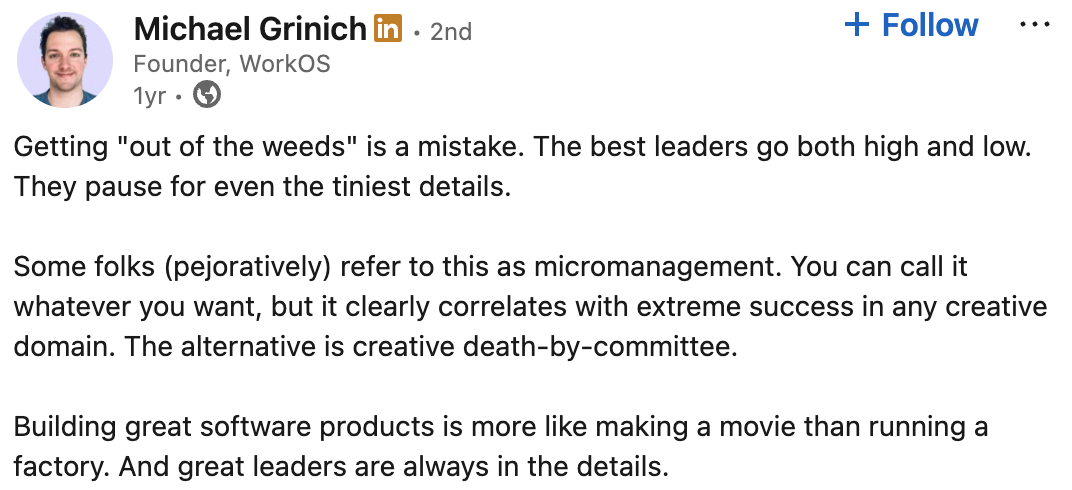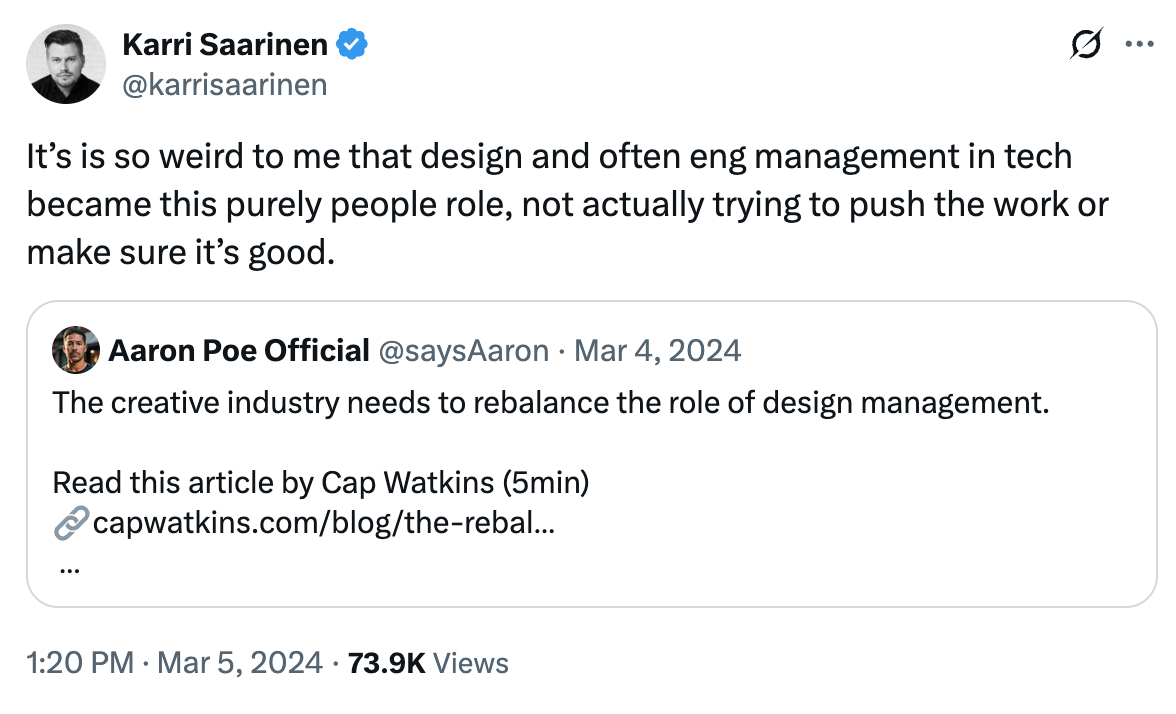Ashby's Leadership Principles
22 minute read
Our Management Philosophy
Before diving into the specific principles, we wanted to outline our philosophical approach to leaders at Ashby. As the Ashby team and business grows, it’s particularly important to clearly outline and set expectations about Ashby’s Leadership Philosophy, which includes the difference between a manager and a leader.

Managers
In other companies, managers primarily focus on process driven work that coordinates a team. Many management attributes and tasks include:
- Organize a large group of people within a company,
- Delegate and manage workflow across and within a team,
- Process-driven systems to streamline and organize work.
We want and expect managers at Ashby to be leaders. We expect leaders at Ashby to be proficient in all of the above tasks and characteristics, but more importantly, leaders should be orienting on and prioritizing the following:
- Inspire: How do you inspire your team to be excited about the work they are doing?
- Challenge: How do you challenge your team with interesting work? How do you ensure that you can retain top performers by enabling them to constantly grow?
- Impact-driven: How do you increase the impact of your team?
Leadership philosophy shaped by the team we are building
Ashby’s leadership philosophy is also shaped by the team that we are building. In our hiring, we deliberately focus on hiring employees who Prioritize Ownership (Operating Principle 4), which means we hire people with high autonomy (and often more experience) who can easily take on more ownership and work relatively independently. This means our management philosophy allows us to have leaders focused on inspiring, challenging, and driving impact over more basic managerial responsibilities.
Aspiring to become a manager
We have Ashby team members who aspire to become managers at Ashby or throughout their career. Our view is that aspirations for becoming a manager should come from wanting to have increased impact and responsibility and leading a team is purely the output. By focusing on impact first, management is more likely to come in time as you can often have increased impact through a scaled team. In reverse (which we want to avoid) is the desire to manage people for the sake of management.
Why Leadership Principles Matter
Similar to the why behind our Operating Principles, expressing and documenting our Leadership Principles clearly sets expectations for current and aspiring leaders at Ashby.
These principles highlight what leaders should be prioritizing in their role as they manage their team, and provide clarity to their team around what they can expect in turn from their manager. Documenting these principles removes ambiguity and potential misalignment and allows us to instead focus on executing at a higher degree of productivity.
Of course, individual leaders are still encouraged and able to follow their own management and personality style and meet the needs of goals of their team — while still operating within these Leadership Principles.
Ashby’s Leadership Operating Principles
The Leadership Principles are roughly in priority order.
- Team performance is your top priority
- Be in the details
- Disagree and commit
- Optimize globally & don’t point fingers
- Communicate broadly with relevance & context in mind
- Foster Ashby’s Operating Principles
- Lead with empathy and respect
- As a leader you represent Ashby
1. Team performance is your top priority

Summary:
- Leaders at Ashby demonstrate excellence in the discipline that they are leading.
- Leaders are expected to attract, retain, and grow top performers within their team.
- Leaders push their team for continuous improvement, setting clear and ambitious goals and being flexible in the initiatives to achieve their goals.
The top responsibility as a leader at Ashby is the performance of their team, which in turn reflects on the performance of the leader themselves.
There are a number of components to team performance that the leader is responsible for:
- Attract the right talent to the team, maintain a high hiring bar, and actively contribute to bringing top talent into the candidate pipeline. This is a continuation of the Operating Principle 5 “Be frustratingly patient about hiring.” It is the team leader’s job to be patient and only accept top talent in their team.
- Measure by staying very close to team performance and constantly setting and holding the team to high standards. The team leader should be discerning and pay particularly close attention to performance during the first 30/60/90 days.
- Grow top performers. The team leader should challenge their team by putting members of their team on the right projects, identify constructive areas of improvement, and share feedback frequently. Note: We deliberately have less of a focus on mentoring junior people given the profile that we typically hire.
- Retain people. The longer top performers stay at the company, their impact multiplies and so it is the team leader’s job to retain top performers. Top performers stick around when they work with other top performers (attracting high quality) and are challenged and growing through interesting work.
- Right person, right role. Great leaders understand the specific skills required for each role and each specific project (which can be unique) and ensure they have the right person filling it. This often applies to the engineering team, where we make a conscious effort to strategically place engineers against projects where they have strong skills and experience.
Leaders set the bar
Leaders at Ashby demonstrate excellence in the discipline that they are leading. They may build a team with people who have specialized skills and experience that exceeds their own in a certain area, but overall the leader is inspiring to their team and leads through their own excellent performance. This in turn, will make it easier for that leader to attract, grow, and retain members of their team.
Leaders at Ashby also constantly set the bar higher through the goals they set and exceed for their team or the pace with which they work. They are pushing their team to try new initiatives, are comfortable de-prioritizing or cutting things that aren’t impactful, and do not settle for the status quo.
This Leadership Principles builds on Operating Principles 7 and 8 to Aim High and Implement Continuous Improvement.
2. Be in the details

Summary
- Leaders should understand the day to day operations of their team and be able to have detailed conversations about your work (as well as setting the big picture strategy).
- Leaders should regularly do “tours of the shop floor” to identify areas for improvement across all levels of their function.
We expect our leaders to be in the details with their team. We believe that the most impactful leaders should be able to set the strategic direction and goals for the team, while also being able to go deep by asking precise, incisive questions and fundamentally understand the details of your work. This enables leaders to more effectively understand challenges, spot patterns, and help create new systems, processes, or projects that are impactful for the entire team and ultimately our customers.
Being across the details of a project or challenge allows managers and leaders to express their preference or recommendation for how to move forward. If a manager is out of the weeds for an extended period of time, they will often express preferences late which means work has to be redone or done differently to the preferred approach.
This is one of the secrets to why founder-led companies have superpowers. Founders care about the details, constantly. This mindset doesn’t have to be (and shouldn’t be) limited to founders!


For project work, we expect leaders to give people projects that are ambitious but achievable. In those instances, being in the details includes:
- Staying close to the project with a clear understanding of the goals and what is happening,
- Holding a high quality bar and assessing quality,
- Having detailed, problem solving conversations together where needed.
We also expect individual contributors to proactively bring the details to their manager and seek out their input as they progress or need input.

For day to day operations, leaders should be doing regular tours of the “shop floor.” This means leaders will prioritize being on the front lines (responding to support tickets, joining customer calls, etc.) and generally staying in the details.
If you see your manager poking around in the details, it doesn’t mean they don’t trust you!
Caveat: Being in the details should not be mistaken for valuing micro-management or the leader doing all the detailed work themselves. By setting the expectation through Operating Principle 4 of Prioritizing Ownership, we expect all individual contributors to own and drive their own work and projects largely independently, but they in turn can expect to be able to have conversations with their managers about the weeds of their work that provide them with value to move forward.
3. Disagree and Commit

Summary
- Leaders are encouraged to have robust discussions and strong points of view that are informed by data and first principles. However, once a decision has been made by Ashby as a company, leaders must “disagree and commit.”
This is an addition to Operating Principle 10: Foster Constructive Debate and Feedback that is specific to leaders.
We expect leaders to foster debate and share feedback within their own teams and also across the management and leadership teams. It is expected that leaders will often have a strong point of view on decisions that need to be made across the business and will sometimes disagree on decisions that have been made.
Once Ashby as a company has made a decision, leaders need to support that decision. Leaders should not disagree with decisions that have been made in front of their team. Public misalignment between the leadership team quickly erodes trust in leadership and the company broadly.
Decisions should be shared with their team with all the relevant context, information that was considered, and criteria for making the decision (where appropriate to share) so that teams can understand how and why decisions were made. As we gather new information, data points, or the circumstances change, decisions may be revisited directly with the relevant people involved.
4. Optimize globally & don’t point fingers

Summary
- Leaders are expected to prioritize decision making for the Customer —> Company —> Team —> Self
- Leaders should be focused on continuous improvement and be able to challenge others leaders directly. However, leaders should never point fingers behind the back of another team or colleague.
Customer —> Company —> Team —> Self
Leaders are expected to prioritize decision making for the Customer —> Company —> Team —> Self (consistent with the Optimize Globally Operating Principle).
Dysfunction starts spreading quite quickly once leaders start to optimize for their teams or themselves above all else. Leaders need to keep the end goal in mind which is (1) doing what is best for the customer, and (2) growing a successful business.
There are likely to be differing opinions on “what is best for the customer” but approaching those conversations with this priority ranking at the forefront is helpful.
Challenge directly, but don’t point fingers
This closely overlaps with Principle 3 “Disagree and Commit” above.
We expect leaders to demand high performance from their own team and also from others. So we expect leaders to challenge things they don’t agree with (before a final decision is made) or don’t think is up to the Ashby standard directly with the person responsible (i.e. another team leader). This means sharing relevant feedback, observations, and recommendations with another team leader. Do not point fingers behind the backs of others.
These are not behaviors that we are seeing at Ashby, but we want to get ahead by clearly setting these expectations.
5. Communicate broadly with relevance & context in mind

Summary
- Clear and compelling communication is one of the main jobs as a leader. Leaders should be regularly communicating their team’s goals, progress, key initiatives, challenges, and celebrating wins across the business.
- Leaders should have a high level of business acumen and align their team’s priorities and focus with those of the business.
Clear and compelling communication
Clear and compelling communication is one of your main jobs as a leader. Leaders should be able to clearly and effectively communicate your goals, strategy, initiatives, and results to your team and the Ashby team to motivate them.
Ashby’s default approach is to be transparent in the information and context that we share because we believe broad and relevant context helps motivate individuals and understand the broader context in which they are operating and how their work is impactful. Leaders should spend a decent amount of time sharing information with relevant context and ensuring that information is cascading in a clear and time sensitive way to avoid confusion.
For example, a leader should communicate to their team why they are backfilling a role before telling another part of the business or opening the role to the public.
Master upward, downward, and lateral communication
All the usual communication principles are especially important for leaders who model communication best practices for their team. Make sure you include clear recommendations, summaries, calls to action / next steps, and structure your communication in a way that is easy to consume. This expectation applies to every format of communication — emails, proposals, decks, Looms, etc.
- Upward: Keep your manager in the loop and bring them relevant updates to help them stay in the details. It’s often helpful to structure these updates as “here are some updates, this is a decision I need to make and I’m planning to go with X for Y reason, let me know if you disagree”.
- Downward: Ensure you translate broader business context for your team, and get them excited about the impact of their work.
- Lateral: Understand which decisions or process changes you make may impact teams around you and communicate clearly and get input in advance so no one is caught off guard.
As Ashby continues to grow with more team members, proactive communication laterally across leaders of key priorities and projects will ensure leaders can then focus on downward communication for their own teams about items that affect their work or customers.
Become business savvy
It is helpful for leaders to be able to communicate to their teams and in turn help them learn about items like:
- Fundamental business (SaaS) metrics and how Ashby is performing QoQ or YoY and also against industry standards
- How startup equity works (broadly and at Ashby specifically)
- Different priorities and initiatives across the business, how they all work together and their relative impact
We will help leaders get up to speed on these items through Management Training.
6. Foster Ashby’s Operating Principles

Summary
- Leaders are responsible for fostering and emulating Ashby’s Operating Principles.
Leaders have a responsibility to emulate and foster Ashby’s Operating Principles. If leaders don’t emulate these principles, then nobody will. You should also provide feedback to your team when they deviate from these principles and also when they embody them particularly well (i.e. tying feedback back to the principles).
Leaders are particularly encouraged to pay attention to Principle 2: Reflect on How You and Your Team Use Time. Practice strong time management skills, run structured meetings, and regularly check in if your team is spending time on the right and most impactful things.
7. Lead with empathy and respect

Summary
- Leaders must lead with respect, empathy, and be invested in their team’s well-being, development, and professional success.
Leaders at Ashby should possess the Ashby Team Attributes outlined in the Operating Principles and be invested in their team’s well-being, development and professional success.
While team performance is the top priority for leaders, we want to avoid “effective assholes” and believe that respect, empathy, and low-ego are key attributes for leaders at Ashby. Leaders should be able to achieve this by being in the details, having a good understanding of your day to day work and challenges, fostering an environment where employees feel comfortable sharing constructive feedback, ideas, and mistakes — which allows leaders to have a strong sense of their team’s capacity, engagement, well-being, and morale.
8. As a leader you represent Ashby; behave accordingly

Summary
- Leaders must be mindful of representing the Ashby brand both internally and externally.
Once you are a leader, you are speaking on behalf of the company in any internal or external context. Be mindful of opinions you share and make sure they are consistent with the Ashby brand.
Making It All Work Together
These eight Leadership Principles add to and complement the 10 Ashby Operating Principles and Team Attributes. While these are lengthy, they are practical. They make an impact because they are lived and acted out by leaders at Ashby.
When hiring and promoting to leadership roles, we will have a strong focus on the principles and team attributes outlined above in addition to the required job-specific skills and experience.
Finally, we expect this document to change over time as we learn and grow as a team.



